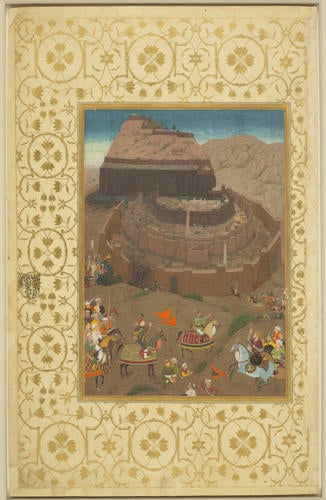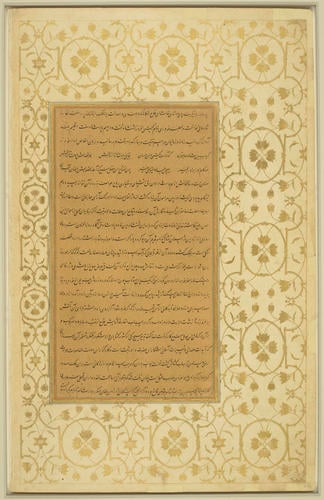The Siege of Daulatabad (April-June 1633) c. 1635 - 1650
Painting in opaque watercolour including metallic paints. | 34.2 x 24.0 cm (image) | RCIN 1005025.af

Murar
Master: Padshahnamah ?????????? (The Book of Emperors) ?? Item: The Siege of Daulatabad (April-June 1633) c. 1635 - 1650

Murar
Master: Padshahnamah پادشاهنامه (The Book of Emperors) Item: The Siege of Daulatabad (April-June 1633) c. 1635 - 1650



-
Padshahnamah fol. 144r
(plate 31)
Mahabat Khan conquers the Daulatabad Fort in June 1633.
The Mughal conquest of the great fortress of Daulatabad, the capital of the Ahmadnagar Sultanate, was key to the consolidation of Mughal power in the Deccan, with Bijapur and Golconda submitting soon afterwards. A topographical view of the immense fortress dominates this painting of the event. The fort comprises a citadel on top of a granite mountain surrounded by a deep mount, shown in profile, and an adjoining fort with by three protective walls, shown from a high oblique angle. Other topographical views are known to have been painted of the site, including one which Shah-Jahan sent to Shah Safi of Iran in 1637.
The Padshahnamah includes a detailed description of long siege and the illustration shows several events that took place over a period of days. The Mughal military leaders are shown in the foreground: Nasiri Khan arrives on his grey horse (on the right), and further ahead of him behind a rockface are Khan Dawran and by Mahabat Khan (in full armour). The plan was to assemble the army at dawn and for a mine to be sprung as soon as it became light, but the officer in charge of the mine mistakenly fired the mine earlier (shown centre left) before the commander-in-chief’s arrival with the storming party. Mahabat Khan (the Khan Khanan, and highest in rank) almost led the storming in person but Nasiri Khan insisted he did so instead. The painting shows the Mughal forces having already entered the fort, opened the main gate, and raised orange Mughal flags from the parapets. On 27 June 1633, Mahabat Khan entered the fort and had the khutbah (Friday sermon) read in the mosque in Shah-Jahan’s name as testimony to the conquest.
The artist Murar signed the painting on the border of the flag at the lower right of the scene ‘work of the slave of the court Murar, the hopeful’ expressing his desire for adequate compensation (payment) from the Emperor for his work.
Bibliography:
Milo Beach and Ebba Koch, King of the world : the Padshahnama, an imperial Mughal manuscript from the Royal Library, Windsor Castle, 1996
Saqib Baburi, Beyond the Akbarnamah: Padshahnamahs and Official Regnal Chronography for Shah-Jahan Padshah (r. 1037/1628-1068/1658), 2010.Provenance
Illustration from a Padshahnamah manuscript formerly in the Mughal imperial library and acquired by Asaf al-Dawlah, Nawab of Awadh, c.1780-90; presented by Saadat Ali Khan, Nawab of Awadh, to George III via Lord Teignmouth in June 1799.
-
Creator(s)
(illustrator)Acquirer(s)
-
Medium and techniques
Painting in opaque watercolour including metallic paints.
Measurements
34.2 x 24.0 cm (image)
58.4 x 36.9 cm (page dimensions)
Category







